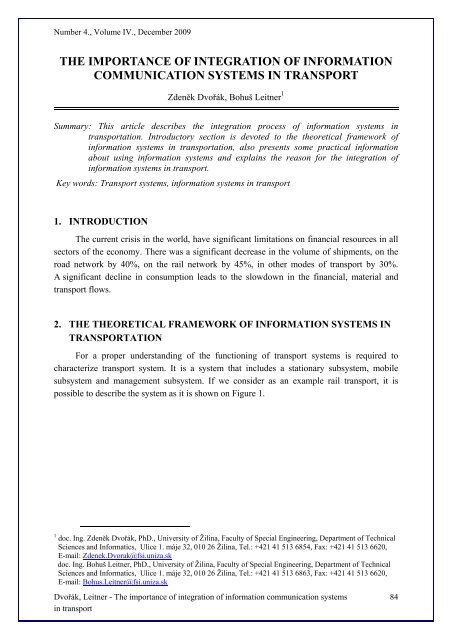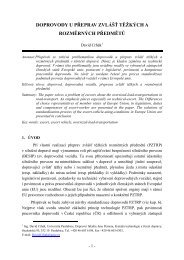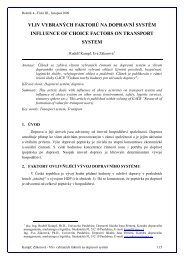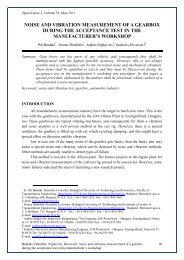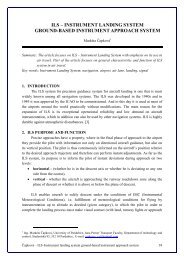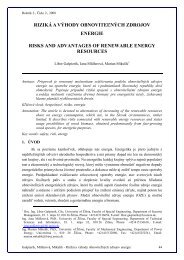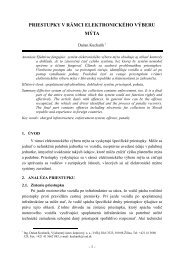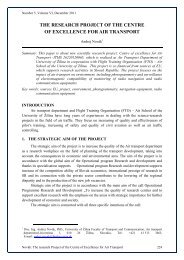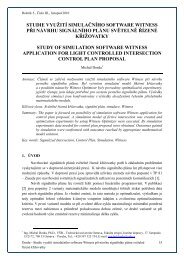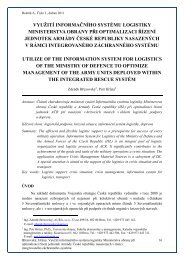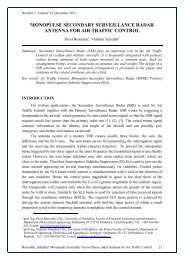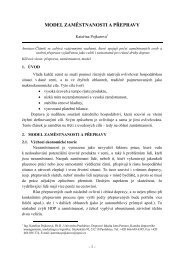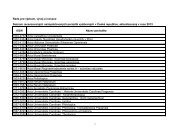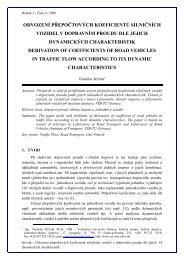The importance of integration of information ... - Perner's Contacts
The importance of integration of information ... - Perner's Contacts
The importance of integration of information ... - Perner's Contacts
You also want an ePaper? Increase the reach of your titles
YUMPU automatically turns print PDFs into web optimized ePapers that Google loves.
Number 4., Volume IV., December 2009THE IMPORTANCE OF INTEGRATION OF INFORMATIONCOMMUNICATION SYSTEMS IN TRANSPORTZdeněk Dvořák, Bohuš Leitner 1Summary: This article describes the <strong>integration</strong> process <strong>of</strong> <strong>information</strong> systems intransportation. Introductory section is devoted to the theoretical framework <strong>of</strong><strong>information</strong> systems in transportation, also presents some practical <strong>information</strong>about using <strong>information</strong> systems and explains the reason for the <strong>integration</strong> <strong>of</strong><strong>information</strong> systems in transport.Key words: Transport systems, <strong>information</strong> systems in transport1. INTRODUCTION<strong>The</strong> current crisis in the world, have significant limitations on financial resources in allsectors <strong>of</strong> the economy. <strong>The</strong>re was a significant decrease in the volume <strong>of</strong> shipments, on theroad network by 40%, on the rail network by 45%, in other modes <strong>of</strong> transport by 30%.A significant decline in consumption leads to the slowdown in the financial, material andtransport flows.2. THE THEORETICAL FRAMEWORK OF INFORMATION SYSTEMS INTRANSPORTATIONFor a proper understanding <strong>of</strong> the functioning <strong>of</strong> transport systems is required tocharacterize transport system. It is a system that includes a stationary subsystem, mobilesubsystem and management subsystem. If we consider as an example rail transport, it ispossible to describe the system as it is shown on Figure 1.1 doc. Ing. Zdeněk Dvořák, PhD., University <strong>of</strong> Žilina, Faculty <strong>of</strong> Special Engineering, Department <strong>of</strong> TechnicalSciences and Informatics, Ulice 1. máje 32, 010 26 Žilina, Tel.: +421 41 513 6854, Fax: +421 41 513 6620,E-mail: Zdenek.Dvorak@fsi.uniza.skdoc. Ing. Bohuš Leitner, PhD., University <strong>of</strong> Žilina, Faculty <strong>of</strong> Special Engineering, Department <strong>of</strong> TechnicalSciences and Informatics, Ulice 1. máje 32, 010 26 Žilina, Tel.: +421 41 513 6863, Fax: +421 41 513 6620,E-mail: Bohus.Leitner@fsi.uniza.skDvořák, Leitner - <strong>The</strong> <strong>importance</strong> <strong>of</strong> <strong>integration</strong> <strong>of</strong> <strong>information</strong> communication systemsin transport84
Number 4., Volume IV., December 2009Fig. 1 - Relationships <strong>of</strong> subsystems in the transport systemSource: Authors3. INFORMATION SYSTEMS IN PRACTICEIn the context <strong>of</strong> the concept <strong>of</strong> the transport system, it is important to define theconcept and <strong>information</strong> systems in transport. Usually these <strong>information</strong> systems will provide<strong>information</strong> on the status <strong>of</strong> infrastructure, the state <strong>of</strong> the vehicle and its load and driver - hisability, fatigue, disposition and experiences. Let’s have a look on examples <strong>of</strong> stationary andvariables <strong>information</strong> system for passengers in the bus and air transport.Transport systemStationary subsystemMobile subsystemManagement subsystemSource: AuthorsFig. 2 - Preview <strong>of</strong> stationary variables and passenger <strong>information</strong> systemsDvořák, Leitner - <strong>The</strong> <strong>importance</strong> <strong>of</strong> <strong>integration</strong> <strong>of</strong> <strong>information</strong> communication systemsin transport85
Number 4., Volume IV., December 2009In real life, as part <strong>of</strong> the management subsystem are still more and more implementedmanagement systems based on real monitoring <strong>of</strong> the transport system – See figure -management <strong>of</strong> highway transport in large agglomerations.Source: www.ndsas.skFig. 3 - Example <strong>of</strong> integrated <strong>information</strong> system for traffic on the highway3. THE INTEGRATION OF INFORMATION SYSTEMSIntegrated Information System (the IIS) is generated from data base, data structure,hardware, s<strong>of</strong>tware and organizational links. It usually has more complicated, complex andprecise links, while the number <strong>of</strong> elements in the <strong>integration</strong> decreases. IIS is in comparisonto usual IS more complex, dense and comprehensive. <strong>The</strong> ideal IIS is done by complete<strong>integration</strong>. Currently it is based on the basic <strong>integration</strong> - that means the basic nature <strong>of</strong> theturnover in the <strong>information</strong> system. A typical feature <strong>of</strong> <strong>integration</strong> is the unification andlinking by-now isolated subsystems. Viewing reality is more complex, resulting from thecombined <strong>information</strong> is enriched by many parameters.<strong>The</strong> reason for the <strong>integration</strong> <strong>of</strong> <strong>information</strong> systemsInitial systems are generally decentralized, based on batch data exchange. Creation <strong>of</strong> anew IIS usually requires a high coordination <strong>of</strong> the work sometimes dozens <strong>of</strong> subcontractors.Generally, it is possible to formulate the objectives <strong>of</strong> the following upcoming IIS asfollowing:• to automate the collection <strong>of</strong> corporate <strong>information</strong>,• to integrate the processes and their resulting data and <strong>information</strong>,• to cover all critical processes in <strong>information</strong> system,• to provide accessible <strong>information</strong> system for all production and economic centres,• to create a centralized IIS,Dvořák, Leitner - <strong>The</strong> <strong>importance</strong> <strong>of</strong> <strong>integration</strong> <strong>of</strong> <strong>information</strong> communication systemsin transport86
Number 4., Volume IV., December 2009• to accelerate the flow <strong>of</strong> <strong>information</strong> in society.Integrating <strong>information</strong> systems are organized in two levels:a) horizontal - one <strong>of</strong> the subsystems, the levels,b) vertical - the process <strong>of</strong> getting from one resolution level to another, and to lowerlevels to higher levels - the route aggregation, or data path <strong>of</strong> the most important <strong>information</strong>.Integrated logistics ISVertical <strong>integration</strong>Horizontal <strong>integration</strong>Production ISPersonal ISAccounting IS Financial ISBussiness andmarketing ISSource: AuthorsFig. 4 - Horizontal and vertical <strong>integration</strong>, integrated logistics <strong>information</strong> system<strong>The</strong> strategic objective <strong>of</strong> building IIS is to improve support for management decisionsand pave the way for the creation <strong>of</strong> management <strong>information</strong> system. As a possible model <strong>of</strong>the IIS architecture for construction companies can be used modules listed in Figure 5.In a business environment, are proceeded those activities which have the highestpriority. As an example where in the first stage <strong>of</strong> solution <strong>information</strong> system is introducedto support marketing processes, and processes for the preparation <strong>of</strong> contract. Than followsthe <strong>information</strong> system to support the economic and labour processes. In the next step <strong>of</strong> the<strong>information</strong> system is to support construction management production and <strong>information</strong> systemsupporting the production <strong>of</strong> a construction, such as traffic engineering and other production.Following the introduction <strong>of</strong> various parts <strong>of</strong> IIS it is needed to test it or set a test operation.After tuning problems it is possible to start working in routine operation state. <strong>The</strong> mainbenefits <strong>of</strong> IIS usually cover:• centralized data base, security <strong>of</strong> data processing in real time,• availability <strong>of</strong> a wide number <strong>of</strong> data users,• provision <strong>of</strong> the data base <strong>of</strong> production-economic organizational units distributedoutside the factory,• the provision <strong>of</strong> real data for the top decision-making.Dvořák, Leitner - <strong>The</strong> <strong>importance</strong> <strong>of</strong> <strong>integration</strong> <strong>of</strong> <strong>information</strong> communication systemsin transport87
Number 4., Volume IV., December 20094. CONCLUSION<strong>The</strong> aim <strong>of</strong> the article was to bring insight to the process <strong>of</strong> <strong>integration</strong> <strong>of</strong> <strong>information</strong>systems in transport. <strong>The</strong> present period can be characterized as a period <strong>of</strong> massivedevelopment <strong>of</strong> navigation systems for drivers. It also brings intensive development <strong>of</strong>electronic <strong>information</strong> systems for passengers as well as reconstruction <strong>of</strong> old semi-commandand <strong>information</strong> systems to fully automatic - computerized command and control systems.5. ACKNOWLEDGEMENTSPublishing <strong>of</strong> the article was sponsored by: Centre <strong>of</strong> excellence for intelligent transportsystems and services, ITMS code <strong>of</strong> project 26220120028, University <strong>of</strong> Zilina. SlovakiaERDF – European fund <strong>of</strong> regional developmentProject is co financing from EC sourcesREFERENCES[1] DADO, M. ET.AL. Technológie a služby inteligentnej dopravy, Edis, Žilina, 2007, 1.vyd. ISBN 978-80-8070-691-3.[2] DVOŘÁK, Z. A KOL. Informatizácia, informačné systémy a bezpečnostný manažment,Žilina, 2007. ISBN 978-80-8070-783-5.[3] DVOŘÁK, Z., ČEKEREVAC, Z. Bezpečnostné aspekty informatizácie na príkladeSlovenska a Srbska, In: Zborník z 12. vedecko-odborná konferencia s medzinárodnouúčasťou riešenie krízových situácií, Žilina, 2007. ISBN 978-80-8070-701-9.[4] OLEJNÍK, F., NEČAS, P. Training and simulation under Slovak concept, Itec 2001,Lille, France, Apríl 2001.[5] OLEJNÍK, F., NEČAS, P. International warfare and security, Zarzadzaniebezpieczenstwem, Zbornik z konferencie Miedzynarodowa konferencja naukowa, 75 –82, Krakow, 2000[6] SCHLOSSER, T: Výkladový slovník Inteligentných dopravných systémov, ZdruženieInteligentné dopravné systémy Slovensko, Bratislava, 2003.Reviewers:doc. Ing. Jaroslav Kleprlík, Ph.D.University <strong>of</strong> Pardubice, Jan Perner Transport Faculty, Department<strong>of</strong> Transport Technology and Controldoc. Ing. Radovan Soušek, Ph.D.Czech Technical University in Prague, Faculty <strong>of</strong> Transportation Sciences,Department <strong>of</strong> Economics and Management <strong>of</strong> Transport andTelecommunicationsDvořák, Leitner - <strong>The</strong> <strong>importance</strong> <strong>of</strong> <strong>integration</strong> <strong>of</strong> <strong>information</strong> communication systemsin transport89


